In the world of electronics, knowing the difference between active and passive components is key. Active components, like semiconductors, give energy to circuits. Passive components, on the other hand, can only get energy and use it to store or dissipate it. This difference is vital for making electronic devices, from simple to complex ones.
The choice of components affects how well an electronic device works. Active components, like diodes and transistors, are vital for boosting signals. Passive components, such as resistors and capacitors, help in sending signals and storing energy. Knowing how to use these components helps designers make better circuits.
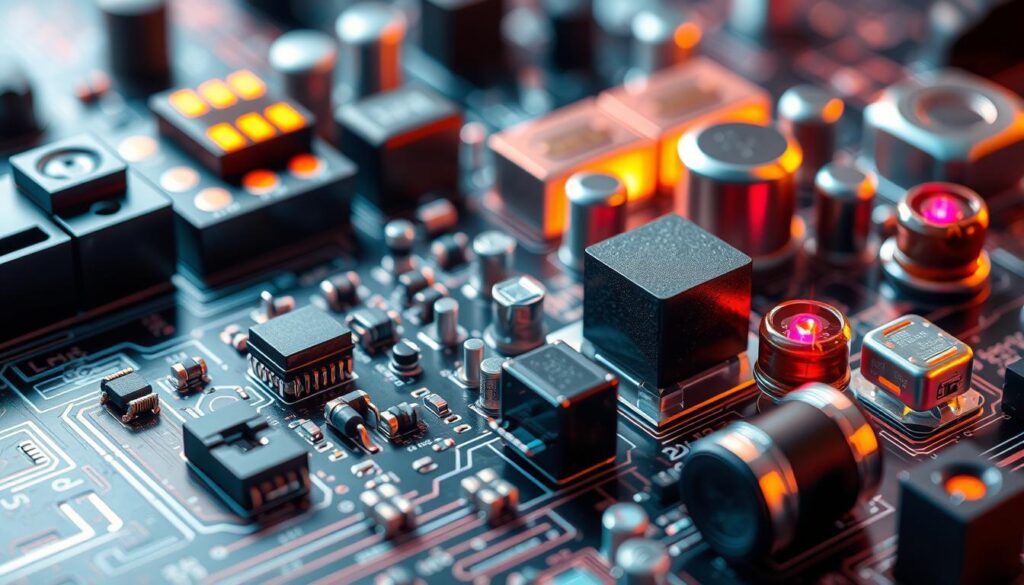
Key Takeaways
- Active components need an outside power source to work, while passive components don’t.
- Active components can boost voltage, current, and power, but passive components can’t.
- Passive components, like resistors, are often bigger than active components.
- Integrated circuits (ICs) are important in modern electronics because they’re small, cheap, and perform well.
- Active components are mainly for signal boosting and changing, while passive components are for sending signals and storing energy.
- It’s important to know the difference between active and passive components for good circuit design in electronics.
- Active and passive components work together to make complex circuits in electronic devices, including semiconductors and other components.
Understanding the Basics of Electronic Components
Electronic components are key to modern electronics. They are vital for making electronic circuits. The global market for these components is huge, valued at USD 186.38 billion. They are divided into active and passive components.
Active components, like transistors and diodes, can change or create electrical signals. Passive components, such as resistors and capacitors, just absorb or store energy.
Knowing the difference between active and passive components is important. It affects how a circuit works. Active components, like microprocessors, are key for processing signals. Passive components, like resistors, control current flow and store energy.
What Makes a Component Active or Passive
An active component can boost or create electrical signals. A passive component can only use or store energy. This difference is key in circuit design.
For example, a transistor can make a weak signal stronger. But a resistor can only lower a signal’s voltage.

The Role of Energy in Component Classification
Energy is key in deciding if a component is active or passive. Active components need outside energy to work. Passive components don’t need outside energy.
Passive components, like capacitors, store energy. They release it when needed. This makes them important in many electronic devices.
Basic Circuit Theory Overview
Understanding circuit theory is essential for making electronic circuits. It’s about how current, voltage, and resistance work together. The mix of active and passive components in a circuit is what makes it work.
By knowing about electronic components and circuit theory, designers can make new and useful electronic products. These products meet the needs of many industries.
Active Components and Passive Components: Key Differences
Understanding the differences between active and passive components is key in circuit design. Active components, like diodes and transistors, need an outside power source to work. They can also boost signal strength. Passive components, such as resistors and capacitors, don’t need an outside power source. They can’t increase signal strength.
In circuit design, active components are vital for all electronic circuits. They provide the energy needed to control electron flow. Passive components, though they don’t create power, are important for keeping circuits stable. Here are the main differences:
- Active components need an outside power source.
- Passive components don’t need an outside power source.
- Active components can boost signals, while passive components can’t.
Knowing these differences is essential for making effective circuit design. It ensures electronic devices work as they should. Designers can make circuits that are both efficient and reliable by understanding the roles of active and passive components.

In conclusion, the difference between active and passive components is a basic idea in electronics. Their differences greatly affect circuit design. By understanding these differences, designers can create innovative and useful electronic devices for various needs.
| Component Type | Description | Examples |
|---|---|---|
| Active Components | Require external source, can amplify signals | Diodes, Transistors, SCRs, ICs |
| Passive Components | Do not require external source, cannot amplify signals | Resistors, Capacitors, Inductors, Transformers |
Characteristics of Active Components
Active components can boost electrical signals, like transistors and operational amplifiers. They are key in devices, making up 60-80% of circuit components. They need power from outside to work and can control or switch signals.
They have power amplification and control capabilities. This means they can make signals stronger and manage electrical flow. They are used in many places, like in hearing aids and audio amplifiers.

Active components come in two types: discrete devices and integrated circuits. Integrated circuits, like operational amplifiers, are used for signal processing. They help make complex circuits that do many things, from simple to complex tasks.
Some common types of active components include:
- Transistors
- Field effect transistors (FETs)
- Operational amplifiers
- Silicon-controlled rectifiers (SCRs)
These components are used in many areas, like consumer electronics and medical devices. Knowing about active components helps designers make complex circuits that work well.
Essential Active Component Types
Active components are key in electronic circuits, giving devices the energy they need to work. Diodes and transistors are two main types. Diodes let current flow in one direction. Transistors boost a signal’s power, making them vital in circuit design.
Some common active components are:
- Voltage sources, such as batteries
- Current sources
- Diodes, including Zener diodes and photodiodes
- Transistors, such as bipolar junction transistors and MOSFETs
These components are used in many devices, from radios and TVs to AI, electric cars, and robots. The need for better, smaller, and more reliable components is driving new ideas in electronics.

Knowing about diodes and transistors is key for making electronic circuits. By picking the right components, makers can build devices that work well and meet their needs.
Transistors: The Building Blocks of Electronics
Transistors are key in today’s electronics. They’ve changed how we live and work. Used in many things like amplifiers and switches, they come in two main types: bipolar junction transistors and field effect transistors.
Types of Transistors
There are many types of transistors, each with its own use. Here are a few:
- Bipolar junction transistors (BJTs)
- Field effect transistors (FETs)
Characteristics and Applications
Transistors are great for boosting or switching signals. They help control electrical current flow. Field effect transistors are often in amplifiers, while bipolar junction transistors are in digital circuits.

The rise of transistors has changed the electronics world. They’ve made devices smaller, faster, and more efficient. As tech grows, transistors will keep shaping our electronic future.
| Type of Transistor | Characteristics | Applications |
|---|---|---|
| Bipolar Junction Transistors (BJTs) | Amplification, switching | Logic gates, amplifiers |
| Field Effect Transistors (FETs) | Amplification, switching | Amplifiers, switches |
Understanding Passive Components
Passive components are key in electronic circuits. They handle energy storage and work in a linear way. Unlike active parts, they don’t need power to work. They just absorb or store energy, making them essential in circuit design.
Energy Storage Properties
Components like capacitors and inductors store energy. This is key in power supplies and filtering signals. For example, capacitors can make power supplies smoother and filter out noise. Inductors help manage energy in power supplies and radio frequency uses.
Linear vs Non-linear Behavior
Passive components can act in a linear or non-linear way. Resistors follow Ohm’s Law, showing linear behavior. But, capacitors and inductors can act differently because they store energy. Knowing how they behave is key to making electronic circuits work well.
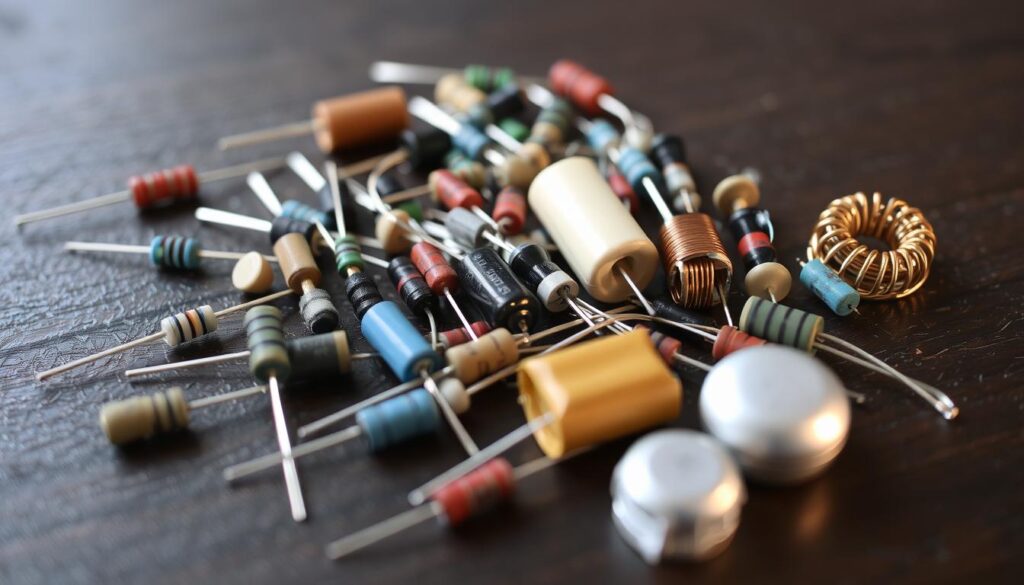
These parts are used in many areas, like consumer electronics and medical devices. By understanding their properties, designers can make circuits more efficient and effective.
| Component | Energy Storage Properties | Linear Behavior |
|---|---|---|
| Resistors | No | Yes |
| Capacitors | Yes | No |
| Inductors | Yes | No |
Common Types of Passive Components
Passive components are key in electronic circuits. They include resistors, capacitors, and inductors. These parts don’t boost the signal and don’t need power to work. Instead, they soak up or hold energy.
Resistors are very common. They help control how much current flows in a circuit. They lower the signal’s voltage and are measured in ohms (Ω). Capacitors, by contrast, store energy as an electric field and are measured in Farads (F). They’re used in filters, oscillators, and power supplies.
Passive components have many uses. For example:
- Resistors: They help divide voltage, limit current, and dissipate heat.
- Capacitors: They filter, couple, and store energy.

In short, passive components like resistors and capacitors are vital in electronic circuits. Knowing how they work and what they do is key to making efficient circuits.
| Component | Function | Unit of Measurement |
|---|---|---|
| Resistors | Control current flow | Ohms (Ω) |
| Capacitors | Store energy | Farads (F) |
Resistors: The Current Controllers
Resistors play a key role in electronic circuits. They control the current flow and protect other components from damage. There are fixed resistors and variable resistors. Fixed resistors have a constant resistance, while variable resistors can be adjusted.
Resistors are used in many applications, from simple circuits to complex systems. They work with other parts like capacitors and inductors. For instance, resistors can set default logic levels and control current in digital systems.
Types of Resistors
There are different types of resistors. Fixed resistors have a fixed resistance. Variable resistors can be adjusted. Then, there are special resistors like thermistors, photoresistors, and varistors, designed for specific uses.
| Type of Resistor | Description |
|---|---|
| Fixed Resistors | Have a fixed resistance value |
| Variable Resistors | Can be adjusted to change their resistance |
| Special Resistor Types | Have unique properties for specific applications |
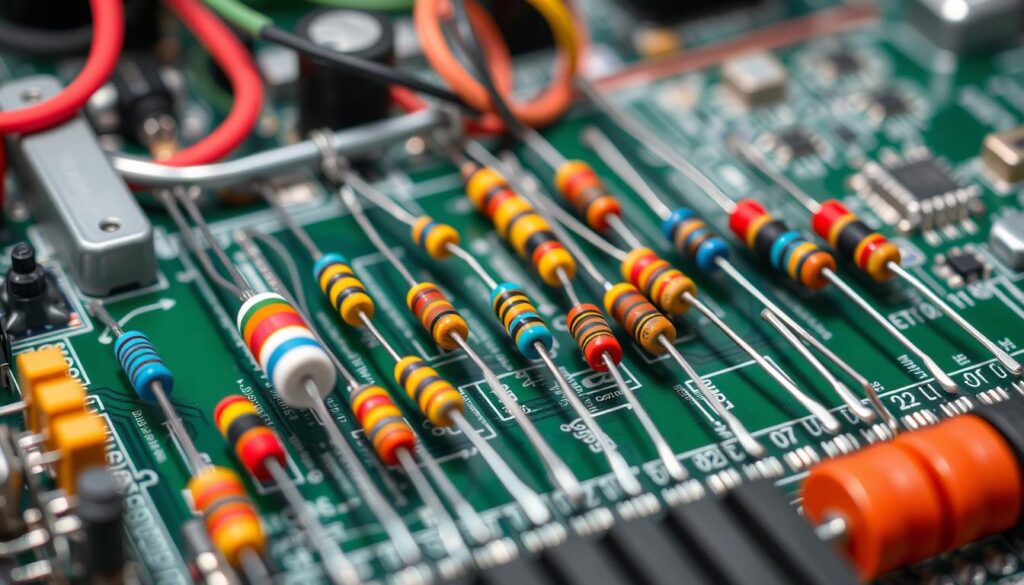
Capacitors and Their Applications
Capacitors are key in electronic circuits, storing energy as an electric field. They come in types like electrolytic and ceramic. Ceramic capacitors are popular for their reliability and small size. They have capacitance from a few pF to 0.1 F or more, fitting many uses.
Ceramic capacitors have voltage ratings from 16 V to 450 V. Their capacitance ranges from 10 pF to 3.3 µF. For instance, the C3225X7S2A475K200AB has a 4.7 μF capacitance and a 100 V DC rating. This makes them great for high-density applications like RF circuits, where they help with high-frequency performance.
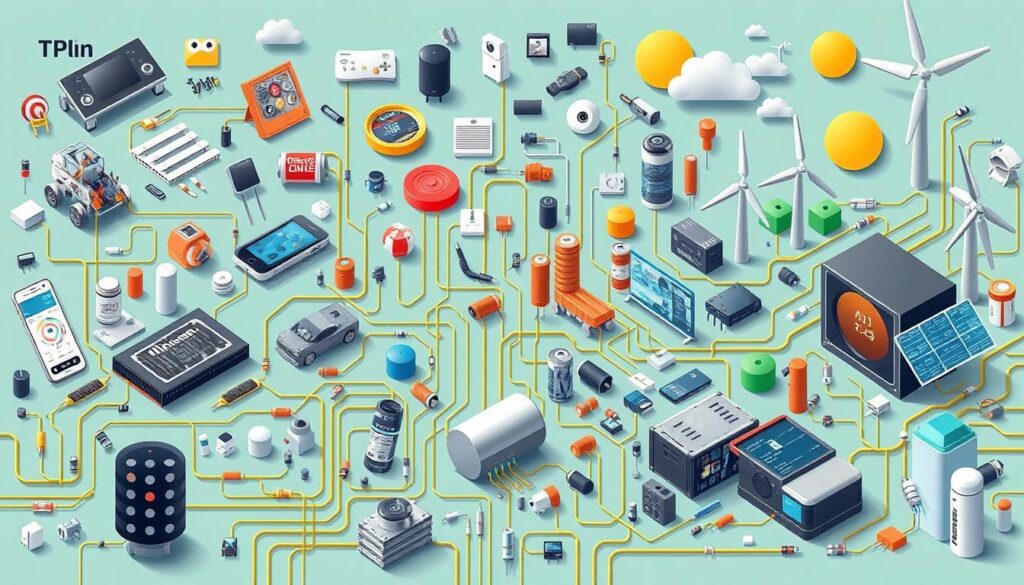
Capacitors are essential in capacitor applications like energy storage, filtering, and impedance matching. They let AC current flow while blocking DC, making them good for repeated cycles. They’re also used in many electronic devices, from simple to complex systems. Knowing about capacitors is key for making efficient electronic circuits.
| Capacitor Type | Capacitance Range | Voltage Rating |
|---|---|---|
| Ceramic Capacitor | 10 pF to 3.3 µF | 16 V to 450 V |
| Electrolytic Capacitor | 1 µF to 1000 µF | 10 V to 450 V |
In summary, capacitors are vital in electronic circuits, with many capacitor applications. Understanding their characteristics and uses helps designers and engineers make better electronic devices.
Real-world Applications in Circuit Design
Circuit design is key in many fields, like consumer electronics and industrial applications. It’s vital for making electronic devices work well and last long. In consumer electronics, it helps make things like smartphones and TVs. For industrial applications, it’s used in control systems and robotics.
Here are some examples of how circuit design is used:
- Designing circuits for consumer electronics products, such as audio equipment and gaming consoles
- Creating control systems for industrial applications, such as manufacturing and processing plants
- Developing medical devices, such as pacemakers and insulin pumps, which rely on complex circuit design
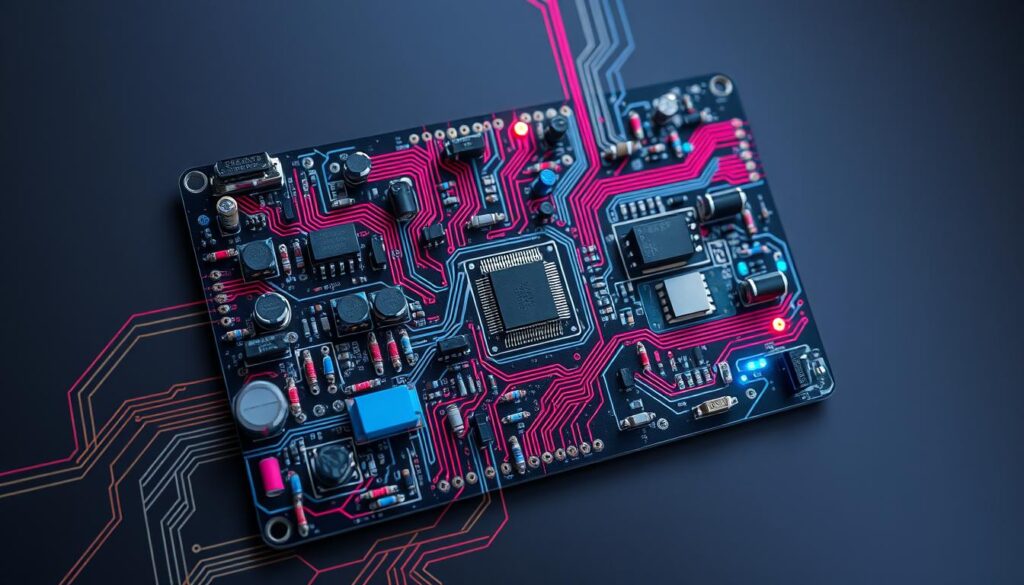
In summary, circuit design is essential in many areas, including consumer electronics and industrial applications. By mastering circuit design, experts can make groundbreaking electronic devices. These devices change our lives and work in big ways.
Power Efficiency Considerations
In circuit design, power efficiency is key. Choosing the right parts can cut down power use. This is vital for saving energy and boosting system performance.
Improving power efficiency involves several steps. Using parts with low power needs is one. Also, tweaking circuit layouts and adding power management can help. For instance, passive components like resistors and capacitors can lower energy loss. Active components like transistors help manage power flow.
Here are some key power efficiency tips for circuit design:
- Component selection: Pick parts with low power ratings and high efficiency to cut down power use.
- Circuit topology: Tweak circuit layouts to reduce energy loss and boost power efficiency.
- Power management: Use techniques like voltage regulation and power filtering to enhance power efficiency.

By focusing on these areas, designers can make circuits that are both functional and energy-smart. This is very important in devices like portable electronics and renewable energy systems.
| Component Type | Power Efficiency | Applications |
|---|---|---|
| Resistors | High | Voltage division, current limiting |
| Capacitors | High | Energy storage, filtering |
| Inductors | Medium | Energy storage, filtering |
Troubleshooting Common Component Issues
Fixing electronic devices often starts with troubleshooting. This means finding and fixing component failures. It involves a series of tests to find the problem’s source. This can be complex, needing a deep understanding of the device’s parts and how they work together.
Common component failures include mistakes by users, bad connections, power issues, and problems with active and passive parts. Technicians use tools like digital multimeters, oscilloscopes, and soldering equipment to solve these issues. By using these tools and a structured approach, they can quickly find and fix problems. This reduces downtime and saves money.
Here are some key steps in the troubleshooting process:
- Visual inspection to identify any obvious signs of damage or wear
- Testing of individual components, such as resistors, capacitors, and transistors
- Use of multimeters and oscilloscopes to measure voltage, current, and other parameters
- Checking for bad connections and soldering issues
- Using a metered power supply to check loads and pinpoint issues

By following these steps and using the right tools and techniques, technicians can efficiently troubleshoot and repair electronic devices. This reduces the risk of component failures and downtime. Regular testing and diagnosis also helps prevent problems by catching issues early.
| Component Type | Failure Rate | Cause of Failure |
|---|---|---|
| Resistors | 10% | Overheating, physical damage |
| Capacitors | 15% | Electrical overload, aging |
| Transistors | 20% | Overheating, electrical overload |
Future Trends in Electronic Components
The world of electronic components is always changing. New technologies and innovations keep popping up. Looking ahead, future trends will be influenced by many things. These include growing demand for gadgets, advancements in healthcare tech, and the need for saving energy.
Some big future trends in electronic components include smaller, more powerful parts. We’ll also see more artificial intelligence and machine learning. The Internet of Things (IoT) will grow too. These changes will boost demand for various electronic components, affecting the market a lot.
Here are some key statistics that highlight the future trends in electronic components:
- The global market for active electronic components is expected to grow by approximately 9% per year from 2023 to 2028.
- The demand for electronic components is driven by a surge in consumer electronics, with approximately 50% of the growth in active electronic components attributed to the consumer electronics market.
- The automotive industry’s transition towards electric vehicles and advanced driver-assistance systems (ADAS) is expected to increase the demand for active components, particularlly power semiconductors, by roughly 25% annually.

The future trends in electronic components will be influenced by many factors. These include technological advancements, changing consumer demand, and the need for energy efficiency. As the market evolves, we’ll see new and innovative electronic components emerge. These will drive growth and development in various industries.
| Market Segment | Growth Rate | Market Size (2025) |
|---|---|---|
| Active Electronic Components | 9% | USD 0.76 Trillion |
| Passive Electronic Components | 4.3% | USD 0.1 Trillion |
Best Practices for Component Selection
Choosing the right components is key to a project’s success. Environmental considerations are very important. The components must handle the device’s operating conditions well. This includes temperature, humidity, and other environmental factors.
Cost analysis is also vital. The cost of components can greatly affect the project’s total cost. It’s important to find components that offer good value. This means looking at their performance, reliability, and durability compared to their cost.
Lastly, performance requirements must be met. The components should match the device’s needs, like speed, accuracy, and power use. By following these best practices, developers can make devices that are reliable, efficient, and affordable.

- Evaluating the component’s datasheet and specifications
- Assessing the component’s reliability and durability
- Considering the component’s compatibility with other components and the device as a whole
- Comparing the cost and performance of different components
Conclusion
Electronic components are the heart of modern electronics. They range from active components that boost power to passive ones that store energy and filter signals. Each part is essential for the complex circuits that power our world.
Components like transistors in smartphones and capacitors in power supplies are key. Resistors control current flow. These components are the hidden heroes behind our devices’ functionality. Knowing how they work helps designers create new, exciting technologies.
The future of electronics is bright, with ongoing advancements in components. This will drive progress in many areas, from gadgets to medical devices. By keeping up with new developments, we can build the technologies of tomorrow.
FAQ
What are the fundamental differences between active and passive electronic components?
Active components, like transistors and diodes, need power to work and can change or control signals. Passive components, such as resistors and capacitors, don’t need power and just affect signal flow.
How do active and passive components differ in their energy requirements?
Active components need power to work and use energy. Passive components don’t need power and don’t use energy.
What are the key characteristics of active components?
Active components, such as transistors and amplifiers, can amplify power, control signals, and change circuit behavior.
What are the common types of active components?
Common active components include diodes, transistors, and operational amplifiers.
How do passive components store and manage electrical energy?
Passive components, like resistors and capacitors, store and manage energy without needing power. They do this in a linear or non-linear way.
What are the primary types of passive components?
Main passive components are resistors, capacitors, inductors, and transformers.
How do resistors and capacitors differ in their applications?
Resistors control current flow. Capacitors store and release energy in circuits.
What role do electronic components play in real-world applications?
Electronic components are key for many applications. They are used in consumer electronics, industrial automation, and medical devices. Each area has its own needs and design challenges.
How can you troubleshoot common issues with electronic components?
To fix electronic component problems, test for active component failures and passive component issues. Use diagnostic tools to find and fix circuit problems.
What are some of the emerging trends and future developments in electronic components?
Future trends include better semiconductor technology, combining active and passive components, and new materials and processes. These aim to improve performance, efficiency, and cost.